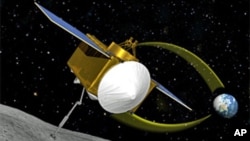In just a few weeks, NASA will launch a bowtie-looking craft into space for a hopeful rendezvous with an asteroid called Bennu.
The ship is called OSIRIS-REx an acronym for the Origins, Spectral Interpretation, Resource Identification, Security-Regolith Explorer spacecraft.
Big Name, What's it Do?
The U.S. space agency is sending the craft to do some pretty impressive things. Perhaps the most impressive is to collect and bring back a sample of rock from the surface of Bennu. Scientists call Bennu a "primitive" asteroid, one that's been around for a long time. They say the asteroid's regolith, the loose rock covering its surface, may "contain the molecular precursors to the origin of life and the Earth’s oceans."
Dante Lauretta, OSIRIS-REx principal investigator, says the origins part of the project is one of the most important because of what it could tell us about our solar system and possibly about life on our planet, and perhaps on other planets got its start. Getting a sample back to Earth for analysis is vital because the spacecraft is only about six meters long with its solar panels deployed. Lauretta says it's not nearly big enough to fit any highly sensitive lab equipment on board that could examine the samples, so they have to bring it back.
How's that going to happen?
The launch window for the spacecraft opens on September 8 and Gordon Johnston, OSIRIS-REx program executive, says NASA's plan will put OSIRIS-REx in the orbit of Bennu in about two years. NASA is giving it plenty of time to find a suitable collection spot, and then the little spacecraft will get close enough to Bennu to deploy a mechanical arm called the "Touch-And-Go Sample Acquisition Mechanism" (TAGSAM).
The craft won't really land on Bennu, but will make contact with the asteroid for about five seconds.
A bucket-like contraption on the end of the arm will scrape up about 60 grams of Bennu's surface and deposit it in an interplanetary suitcase called the Sample Return Capsule. The SRC will be the only part of OSIRIS-REx to make it back to earth. A few years later, the little SRC will hit our atmosphere at a speed of about 12.4 kilometers per second. Two parachutes will slow the SRC down and it should land safely in the Utah desert in September of 2023.
That's a big asteroid!
Another reason the scientists want to take a close look at Bennu is because it's one of the most dangerous asteroids around our solar system. According to NASA, Bennu "... has a relatively high probability of impacting the Earth late in the 22nd century."
Bennu is no little space rock that will sparkle when it hits our atmosphere. It's basically round and has a diameter taller than New York City's Empire State Building. It's traveling at more than 100,000 kilometers per hour and weighs 60 million tons. Bennu gets reasonably close to Earth every six years or so, within 500,000 kilometers. If it hits us, it could do the same amount of damage as the asteroid that almost scoured the planet of all life some 60 million years ago.
Another thing that makes Bennu dangerous is that its trajectory around the solar system is changing because of something called the Yarkovsky effect, which is what happens when a cold piece of rock gets close enough to the sun to warm up. That warmth is energy and that energy has a tiny effect on the asteroid's orbit, changing it just a tiny bit over time.
Getting a chance to study exactly how the Yarkovsky effect works will help scientists who are looking for other objects out there that could be on a collision course with Earth.
That's a lot of responsibility for a little spacecraft! VOA will be covering the launch in September, so stay tuned.









